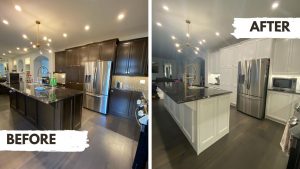Get Your FREE Online Quote Today! Click Here
Questions? Call: 647-355-1969 or 705-627-1725
How Many Coats Of Paint Should You Put On Cabinets?
How Many Coats of Paint on Cabinets?
For the best results, you should apply two coats of stain-blocking primer followed by two coats of high-quality cabinet-grade paint. When painting, use a fine-finish roller for fixed pieces like panels and frames, and an airless sprayer for painting cabinet doors. This method ensures full coverage, a smooth finish, and lasting durability.
Why Two Coats of Primer Are Essential
Priming your cabinets is a vital step in achieving a professional finish. Stain-blocking primer prepares the surface, prevents bleed-through from wood tannins, and provides an excellent base for paint. Here’s why two coats of primer are necessary:
- Sealing the Surface: The first coat seals the wood, while the second coat ensures complete and even coverage, particularly for porous woods like oak.
- Blocking Stains: Primer prevents stains, wood grain, and old finishes from showing through the paint.
- Improved Adhesion: A properly primed surface helps the paint adhere better, increasing the finish’s durability.
Why Two Coats of Paint Are Recommended
Applying two coats of paint is just as important as priming. Here’s why:
- Full Coverage: The first coat may not entirely cover the surface, especially when transitioning from a darker to a lighter color. The second coat ensures uniform coverage.
- Durability: Cabinets experience daily wear and tear. A second coat adds strength to the finish, making it more resistant to scratches, chips, and moisture.
- Enhanced Aesthetic: Two coats of paint deepen the color, creating a richer, more polished look with no streaks or uneven areas.
The Right Tools for Painting Cabinets
To achieve the best finish, it’s important to use the right tools for different parts of the cabinets:
- Fixed Pieces and Panels: Use a fine-finish roller for smooth and even coverage on fixed pieces, such as cabinet frames and panels.
- Cabinet Doors: An airless sprayer is ideal for doors, as it applies thin, even coats with a factory-like finish and eliminates brush or roller marks.
This combination ensures a consistent, professional look across all surfaces of your cabinets.
What Happens If You Skip Coats?
Skipping a coat of primer or paint can lead to a range of issues:
- Visible Bleed-Through: Without primer, wood tannins or stains from previous finishes can seep through the paint.
- Uneven Finish: Skipping coats may leave streaks, patches, or uneven color.
- Poor Durability: Fewer coats result in a weaker finish, making the cabinets more prone to chipping, peeling, or moisture damage.
Step-by-Step Guide for Painting Cabinets
- Preparation:
- Clean all surfaces thoroughly to remove grease, dirt, and grime.
- Lightly sand the surfaces to create texture for the primer to adhere to.
- Prime the Cabinets:
- Use a fine-finish roller to apply the primer to fixed pieces like frames and panels.
- Use an airless sprayer to apply an even coat of primer to the doors.
- Allow the primer to dry completely, then sand lightly to smooth any imperfections.
- Apply a second coat of primer for optimal stain blocking and adhesion.
- Paint the Cabinets:
- Use a fine-finish roller for fixed pieces to ensure smooth and even coverage.
- For cabinet doors, apply two coats of paint with an airless sprayer, allowing each coat to dry thoroughly before applying the next.
- Touch up edges or tight spaces with a small brush.
- Reassemble the Cabinets:
- Once the paint has fully cured, reattach the doors and hardware to the frames.
Tips for a Professional Finish
- Use High-Quality Paint: Cabinet-grade paint is designed to withstand daily wear and tear.
- Work in a Clean, Ventilated Space: Minimize dust and fumes for a smooth finish and a safer work environment.
- Allow Proper Drying Time: Follow manufacturer recommendations for drying and curing times between coats.
- Practice with the Sprayer: If using an airless sprayer for the first time, practice on a test surface to perfect your technique.
How Many Coats of Paint Should You Put on Cabinets?
For the best results, you should apply two coats of stain-blocking primer and two coats of cabinet-grade paint. Use a fine-finish roller for panels and fixed pieces and an airless sprayer for cabinet doors to achieve a smooth, professional finish.
Skipping coats may save time initially, but it can lead to problems like uneven coverage, bleed-through, or reduced durability. By following these steps and using the right tools, you’ll create a stunning, long-lasting finish for your cabinets.
For flawless results, consider consulting with a professional cabinet painting service. They have the tools, experience, and techniques to make your cabinets look brand new.
Get your FREE online cabinet painting quote today! Click Here
TESTIMONIALS
I was extremely pleased with the services I received. Frank & his team at paint my cabinets were great! Trustworthy, reliable and professional! I would highly recommend this company and intend to use them again in the future!
Rose Erman
These guys were great! They quoted me at an unbelievable affordable price and did an amazing job! They were on time, clean, courteous, and professional. I highly recommend this company to anyone looking for a cabinet painter.
Lilian Melo
They did an awesome job. Fast, friendly, neat, cleaned-up well, and at a fair price. I'd highly recommend them.
Braeden Hay



